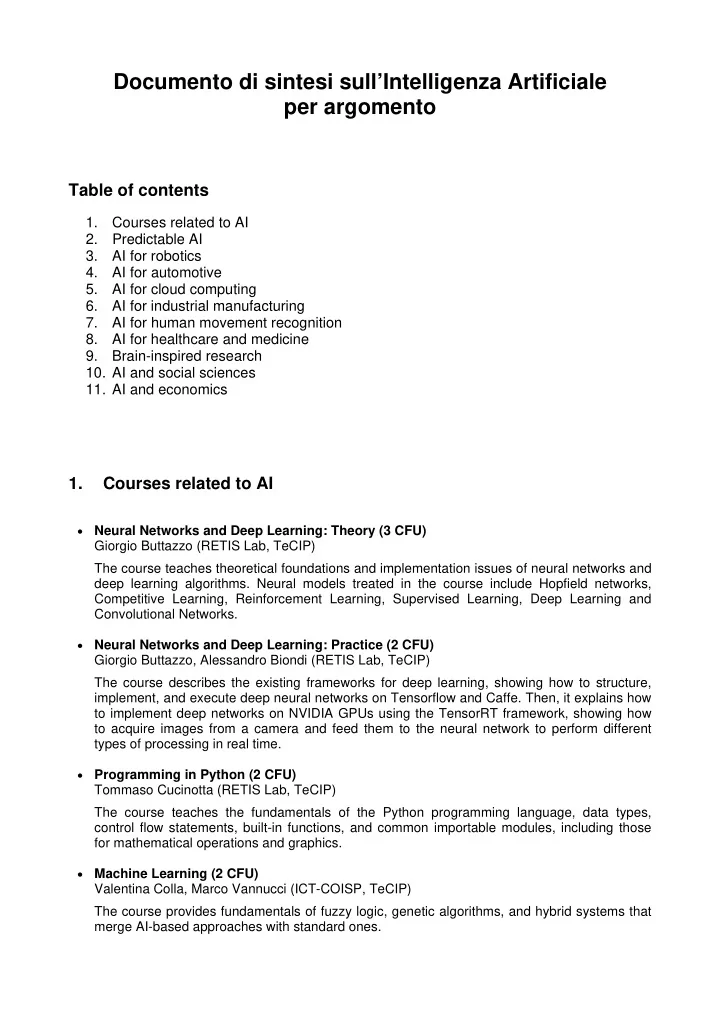

Documento di sintesi sull’Intelligenza Artificiale per argomento Table of contents 1. Courses related to AI 2. Predictable AI 3. AI for robotics 4. AI for automotive 5. AI for cloud computing 6. AI for industrial manufacturing 7. AI for human movement recognition 8. AI for healthcare and medicine 9. Brain-inspired research 10. AI and social sciences 11. AI and economics 1. Courses related to AI Neural Networks and Deep Learning: Theory (3 CFU) Giorgio Buttazzo (RETIS Lab, TeCIP) The course teaches theoretical foundations and implementation issues of neural networks and deep learning algorithms. Neural models treated in the course include Hopfield networks, Competitive Learning, Reinforcement Learning, Supervised Learning, Deep Learning and Convolutional Networks. Neural Networks and Deep Learning: Practice (2 CFU) Giorgio Buttazzo, Alessandro Biondi (RETIS Lab, TeCIP) The course describes the existing frameworks for deep learning, showing how to structure, implement, and execute deep neural networks on Tensorflow and Caffe. Then, it explains how to implement deep networks on NVIDIA GPUs using the TensorRT framework, showing how to acquire images from a camera and feed them to the neural network to perform different types of processing in real time. Programming in Python (2 CFU) Tommaso Cucinotta (RETIS Lab, TeCIP) The course teaches the fundamentals of the Python programming language, data types, control flow statements, built-in functions, and common importable modules, including those for mathematical operations and graphics. Machine Learning (2 CFU) Valentina Colla, Marco Vannucci (ICT-COISP, TeCIP) The course provides fundamentals of fuzzy logic, genetic algorithms, and hybrid systems that merge AI-based approaches with standard ones.
Digital perception (4CFU) Carlo Alberto Avizzano, Paolo Tripicchio (PERCRO Lab, TeCIP) The course teaches the development of intelligent systems to handle data from video/laser sensors. The course targets the use of embedded architectures on dockerized or chrooted, and computer-vision, modelZoo through PyTorch, Darknet and Keras as inference engines. Course topics include: image capture, color handling, perspective geometry and stereovision, feature extraction and classification. Human Motion modeling and Analysis (3CFU) Alessandro Filippeschi (PERCRO Lab, TeCIP) The course provides methods for capture and analyzing human motion using methods of biomechanics, computer vision and machine learning. Kinematic and biomechanical models of the human muscolo-skeletal system will be integrated with bayesian filtering, machine learning and computer vision for the study of motion capture and tracking techniques as well as external load estimation. Computer Vision for Humans and Robots (3CFU) P.Tripicchio ex E.Ruffaldi (PERCRO Lab, TeCIP) Internal course on Vision and Image Processing for human detection and interaction with robots. The course addresses algorithms for face recognition and feature landmarking, human detection, posture tracking, action detection. Ethical and legal issues in data science Giovanni Comandé DIRPOLIS The course illustrates the main legal and ethical issues related to the development and use of AI and big data. It also focuses on the ethical and legal implications of the paradigm shift from causality to probability in the use of data driven applications. Data Protection, Privacy, Ethics and Discrimination Giovanni Comandé DIRPOLIS The course addresses ICT multilevel legal landscape; Data protection legal models and practices (further processing, legitimate interests, data subject rights, access rights with particular attention to the EU and the US models); Algorithms’ regulation (developer’s liability, ethico-legal borders). Discrimination and other legal protection rules (e.g. consumer protection, unfair business practices, competition). Algorithm Accountability Giovanni Comandé DIRPOLIS The course deals with algorithm accountability in the context of Machine Learning. Algorithm transparency and the Marketplace/Competition Law. Methods of transparency. Technical and legal options to enhance transparency & accountability. People analytics. Behavioural “nudging”. New emerging human rights in the age of behavioral data science and neurotechnologies: Towards "mental privacy" and "decision integrity". Legal and ethical implications of computational capacity.
2. Predictable AI The objective of this research is to enable the use of AI algorithms and deep networks in safety critical systems, as autonomous cars, advance robots, and space-crafts. These systems must be certified and must react within given timing constraints to exhibit a correct behavior. Unfortunately, current deep learning frameworks are not designed for a safety-critical systems and do not exhibit predictable response times. To solve this problem the following research is carried out: Enabling safety and security in AI algorithms Alessandro Biondi, Giorgio Buttazzo, Federico Nesti (RETIS Lab, TeCIP) This work exploits an hypervisor architecture to combine a high-performance computing domain (hosting replicas of neural controllers) with a safe, certifiable computing domain (hosting safety- critical components). The safe domain includes a backup controller, a voter, and a monitoring look-ahead module that switches to the safe controller whenever the results produced by the neural one are judged unreliable. Predictable support for concurrent deep networks on GPU platforms Alessandro Biondi (RETIS Lab, TeCIP) This work aims at designing and implementing an inference engine for deep neural networks developed with the TensorRT framework by NVIDIA. This engine allows for time predictable multitasking of a set of deep neural network with different timing requirements to be executed on an embedded GPU (TX2 and Xavier platforms). Deployment of large deep networks on FPGAs Alessandro Biondi (RETIS Lab, TeCIP) With respect to GPUs, FPGAs can accelerate computations with a more predictable timing behavior and much less energy consumption. A major problem of FPGAs, however, is that they cannot contain large deep networks. This work exploits dynamic partial reconfiguration and virtualization techniques to create a larger FPGA, where the network can be partitioned into multiple subnetworks that can be executed in time sharing on the physical FPGA fabric. Enhance predictability in Tensor Flow Daniel Casini, Alessandro Biondi, Giorgio Buttazzo (RETIS Lab, TeCIP) The native scheduler used in Tensor Flow to run deep neural networks on multicore platforms is optimized for the average case, but can introduce unpredictable delays, making it unsuitable to be used for safety-critical applications. The work aims at enhancing predictability by acting on the node scheduler introducing mechanisms designed to handle network specific workload.
Recommend
More recommend